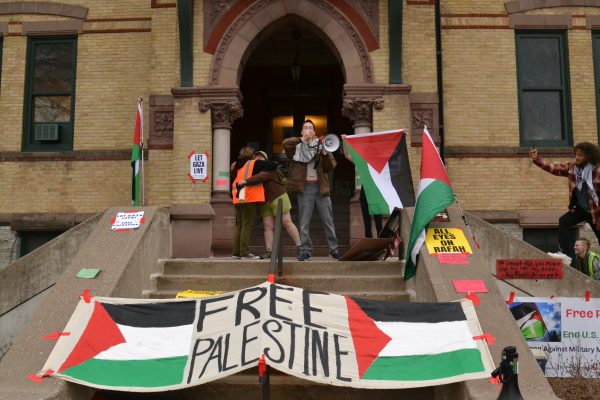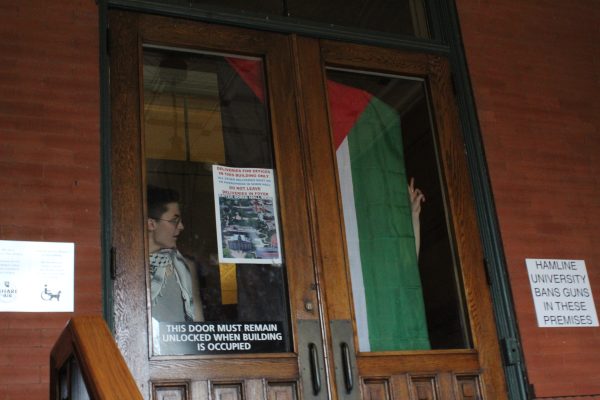When Ferguson Found Them
February 9, 2015
THERE ARE ONLY a few images from the night of Darren Wilson’s non-indictment that I can recall as clearly as the day I saw them. Burning cars and lines of vehicles and people filing toward a police roadblock in the evening twilight. Sitting and watching the CNN feed, I openly wondered if a fully armored Don Lemon actually knew why he was there. The hundreds of protesters facing off with police in the streets of Ferguson have an idea. I imagine so too do the thousands of racist keyboard warriors trolling comment sections and Reddit pages.
The exact details of the incident are still unknown. Though there were several witnesses to Michael Brown’s death, a jury of 12 coupled with conflicting statements from said witnesses was enough to acquit his killer of any charges. Wilson became a national pariah, and Michael Brown became a brother, cousin, son and friend to millions of Americans who asserted that black lives actually did matter. What ensued was a televised nationwide wave of public disobedience that was indeed televised. In late November, two friends of mine, Patience Zalanga and Nancy Musinguzi, travelled to Ferguson as part of a group to document the situation, join the fray, and bring back news from the front. This is their story.
§
IT’S A CHILLY but comfortable 26 degrees as Patience, 22, greets me at the door of her nondescript apartment building. Her neat and stylish flat top accentuates a round face and bright, feline eyes. She has a surprisingly fitting radio voice, low and just a little raspy, and as I sit down at her kitchen table I ask her if she used to be a singer.
She smiles sheepishly and opens her eyes wide, “Oh no… Not me.”
I get the feeling that she’s laughing at some old memory. She’ll do this periodically throughout the duration of my interview with her and, for a second, it’s easy to see why she would be a good choice to document the volatility of Ferguson. She’s not a big woman, and although she has big facial features, her face seems small, almost mouselike. Some people’s appearance more or less dictates their personality but Patience definitely acts more like she sounds. She’s comfortable deferring to other speakers and says yes more often than she says no, backtracking if she doesn’t get something quite right. Her voice doesn’t penetrate the relative silence of her kitchen. It more so merges with the ambient noise of the space, making it easy to succumb to the syrupy rhythm of her cadence.
Born in Nigeria and raised in St. Paul, Patience grew up in a thoroughly academic, Christian, middle class household. After high school she enrolled in a local, nearly all-white private university where she discovered her taste for photography, buying her own camera not long after. It was also a year in which she discovered the near-omnipresent reach of racism. We later agree over the course of several conversations that Minnesota’s “progressive” self-labelling makes it a fertile breeding ground for different forms of concealed hatred. It’s this form of discrimination that drove her out of school and onto the fringes. She ended up leaving after her sophomore year and moving in with a large group of friends in a St. Paul suburb. Over the course of six months, Patience built up a steady resume of online dialogue through her personal Facebook page and a tandem-Tumblr page (The Faithful Witness Project) she runs with Nancy. No doubt seeing her online activism, an old acquaintance from college messaged her with an opportunity to visit the movement in Ferguson.
“It’s funny because he must’ve seen that I was following the movement through all of my posts,” Patience says. “I knew him but I probably hadn’t even spoken to him once since I left school.”
I asked her back in November if she knew who she was going with and she replied that she didn’t. I recall feeling troubled at the time, but I’ve come to understand the sell; one that smacks of adventure and unknown opportunity. Imagine a similar magnetism pulling a young Hemingway to the Italian Front and, for a moment, it’s easy to see oneself strapping a helmet on one’s own head and throwing caution to the wind. It’s not a bad feeling at all.
§
IT TAKES ABOUT 20 minutes of conversation with Nancy Musinguzi to become a fan. The 23-year-old Princeton, NJ native has been living in Minneapolis for about six months now, and she’s thoroughly unimpressed:
“The Twin Cities don’t really have flavor,” she says. “Everybody’s in their own little spot doing their own thing. Complacent. Specifically, there’s no hip-hop culture here, at least not one that I’m aware of,” she says with a giggle.
I’ve been trying to get an interview with Nancy for about a month now and as far as I know this is the first work-related thing she has done since returning from a three-week trip to New York.With a mop of just-shoulder-length dreads, near perfect diction, and a matter-of-fact speaking style, she paints an iconic image of the suffering artist.
Daughter to former Wall Street and airline executives, the Rutgers grad and hip-hop head has an impressive background in hip-hop photography from her time in New York. She’s worked with high-profile publications such as XXL and Complex, and their accompanying high-profile artists. Yet in the wake of her starstruck beginnings, time has afforded her the ability to look back on her subjects with both fondness and disdain:
“Someone like Joey Bada$$, been all over the world: Japan, Europe, whatever. He’s done so much and is always showing love to his home city. But I dare you to find someone who can tell you the last time he did something in his city, for his city. It just doesn’t happen.”
This theme permeates the stories she shares with me. Notions of community, home and belonging aren’t just adjectives for the place of one’s birth. For Nancy, home is something you make or break, and sadly, she’s seen more of the latter]. After her mother’s death in 2013, she received an opportunity from an old friend in the Cities who knew her well. That connection brought her to her current position at a nonprofit in Minneapolis, snapping photos for newsletters and events, as well as opening two separate gallery installations of original work.
Amidst the apparent success, however, lies the lingering sense that she could be doing more. As a photographer, she has the talent and hustle to have her name on speed dial with every high-profile publication in the country. But in my continued conversations with her I find that community-building slots higher on her list of priorities.
“Newark!? Little ass Newark? Dope artists man. You have guys out there that are doing their music, doing their art, and doing it in their communitie,” she says. “Being able to go backstage with Action Bronson, Pro ERA or Flatbush Zombies, it was so enticing to be a part of that world… [but] there was always that wall there. Being a woman, and knowing that they don’t want me there, it’s bullshit. It was always coming into these spaces as an outsider, which is why I wanted to work with Newark artists. Now it’s like, there’s a Vice series on Newark, people are moving there, things are happening. It’s like a Williamsburg with less white people. All of a sudden Newark’s on the map now.”
I get where she’s coming from. As a minority from an upper middle class, suburban background, I left Minneapolis with my family in 2006. Seven years later the city I came back to may as well have been a different country. With the seemingly global millennial tendency for social anxiety, finding a community and a life is a full time occupation in itself. So hearing from Patience about her impending trip to Ferguson, Nancy decided she had to come along for the ride.
“I wasn’t doing anything with my money anyways,” she says, followed by another giggle.
§
NANCY FUMBLED AROUND in the back seat for her iPhone while Patience gripped the steering wheel nervously. It was nighttime on a road somewhere near the Missouri state border. A stoic Iowa state trooper questioned her diligently: License and registration. Do you know why I pulled you over? Step out of the car please. Nancy posted the image she took that night to her Facebook page in real time. The caption:
Iowa State Trooper, license plate # 265, has Patience Samuel Zalanga in his passenger seat. Anything happens from this point on, know this man is held accountable for any unlawful actions that transpire.
“That was a legitimately dangerous situation. She didn’t have her ID, it’s five black kids driving a car across state lines. It wasn’t even our car, it was a friend’s.”
Nancy’s sitting nonchalantly on her couch with her Mac sitting securely on her lap. This is the first time the girls have seen each other since December, and Patience shrieks in delight when they first see each other. Now the two share a mid-sized couch, Patience comfortably folded up in a corner.
“I was so nervous in that moment,” Patience explains, “I had lost my ID before we left, so I just got my yellow papers (interim identification documents) but they were in the back of the trunk with all our stuff so we never would have found them.”
“It was a crazy look,” she says with a laugh, “Like when I think about it, it was me, Nancy, Justin, Hoda and Jobi. You have a black man, a trans black boy, a black muslim woman, a queer black woman, and me, a black woman. It was such a… such a wide range of like, blackness!”
Both smile and laugh at that last statement. The more I watch them interact and reminisce on the trip, the more it seems like they are veterans returning from deployment. As a journalist I’m aiming for the breaking point in their collective relationships, looking for some compelling fissure to deconstruct. As veterans will, however, the group as a whole has agreed to leave some things unsaid. They hint at disagreements, secrets and other insider tales, but just as subtly refuse to elaborate. It’s an unsettling experience to speak with people who knowingly and openly holds things back. Ironically or not, I feel like an outsider, the new kid on the block who doesn’t quite have the keys to the castle yet.
Surviving that first run-in with police, the group traveled over ten hours to make it to Ferguson. They connected with organizers of Millennial Activist United (MAU), the female auxiliary of the Black Lives Matter movement in Ferguson, and the male auxiliary Black Souljahz. Working closely with MAU, the group was housed in the bottom floor of a duplex owned by a relative of one of the organizers. Settled in and running on about two hours sleep, the group spent much of their first day packaging meals for the demonstrators in the St. Louis suburb and learning about the city they had now placed themselves into.
“The atmosphere in Ferguson, before the news of the non-indictment came out, it was just tense,” Patience says. “People were really on edge about what was going to come. But it was also so loving. Everywhere there were people offering up food, water, a place to stay. It was really comforting.”
While the group grew close in some ways and apart in others, there’s a sense of unfailing love there that is, again, akin to veterans. Spending most of their time together, they had to find creative ways to have alone time. For Patience that was listening to music on the toilet. For others, finding time to chill at a coffee shop took on added importance. Coffee shops were regular sites for gatherings, meetings, and moments of respite. The group itself as well as many of the organizers regularly communicated with the world at large through social media. Later on these same coffee shops became targets for police and in one notable instance, an entire shop was tear gassed. In this type of environment, the leadership of the organizers in charge of the demonstrations was critical. Particularly in demonstration tactics:
“One of the things we did was when the police would start threatening to arrest people, we would leave!” says Patience. “We didn’t want to get arrested, we didn’t want to get maced, y’know? I think a lot of people were confused by that, saying ‘I thought we were here to resist.’ But there’s a certain level of resistance [in demonstrating]. One of the things a leader said later was that we do not have to be martyrs for our cause. I really appreciated that.”
Movement leaders also warned against the possibility of undercover police officers running sting operations against demonstrators. On Nov. 22, news outlets across the country reported on the arrests of two New Black Panthers for attempting to craft pipe bombs for use against Ferguson officials. The group was repeatedly told not to join any bomb making efforts. It’s an intriguing conspiracy theory that I have no means of verifying, but it raises some interesting questions. Everything that Nancy and Patience have told me so far points to a largely non-violent movement. There were none of the action-packed stories of clashes with police that I had naively come to expect. As worried and apprehensive as they seemed to be before going down, much of the stress seemed to be mental rather than physical. The more successful the movement grew, however, the more adept police became at surveilling and tracking the protester’s movements.
“They [St. Louis police] were looking at their [organizers’] Twitters, and probably their text messages as well. We would try to stay off of those things and just use word of mouth. But either way the cops always knew. It was interesting to see the helicopters travel so quickly to the next location. It was creepy. It was really creepy,” Patience said.
In continually mentioning the movement organizers, Nancy points out that major news outlets didn’t spend much time attempting to unearth the complexities or even the identities of the demonstrator population in the days proceeding and following the verdict.
“The Ferguson Black Lives Matter movement had 13 leaders, and nowhere in a major news service are those people’s names, faces, or backgrounds described,” she gripes.
She explains to me now that theleaders there were mostly women and some men, split between MAU and the Black Soldiers, which together comprise the Black Lives Matter movement. It comes as a mild shock to hear from Patience that much of the arrests, the violence and unrest that flickered across TV screens were instigated by people with little to no vested interest in Michael Brown’s death.
“There was a group for the Communist party that was there, and they were really big agitators. They would fight with police and ask to be arrested. That’s when people realized that there were a lot of people just co-opting the movement and a lot of people just stopped showing up. Reading the news and hearing about how 13-15 people got arrested one night, I realized they were all Communist Party demonstrators.”
After saying their goodbyes and promising to come back, the group hit the road for Minnesota, weighed down with the stories, images and emotions of everything they had just experienced.
“I remember unloading all my stuff and walking in [the house] and I’m like ‘Where is everyone?’ I go downstairs and everyone is just glued on the TV and then I hear it.” Darren Wilson would not be indicted for his killing. “I remember a feeling of horror. Feeling like, I can’t have black babies. That no matter what, if you’re black and male, you’re not safe.”
The group quickly reformed and set out for Ferguson the next day, having missed the big event. It was something deeper, however, than just being there for the verdict. Asking them what’s changed since their return, they shared this question and provided some of the most compelling and memorable dialogue I’ve heard on the issue of activism. It’s January now and both Patience and Nancy have changed a great deal from their trip. I don’t say it out loud but I continually hear the veteran in them come out as they point out their own pre-trip naivety. For both of them, middle class black women with continental African (not American) roots, their acknowledgement of a lack of belonging with the movement is a strong one:
“This concept of belonging, feeling that you have a place in something. That you fit in somewhere. That there’s a sense of home, a sense of connectivity, I’m constantly reevaluating that. You have to feel like you have a stake in things. I don’t feel I have a stake that is mine. My being black is not enough,” Nancy says. “When I confront racism, usually it’s in a predominantly white space. I always have agency. Poor black people don’t have those choices because they’re not afforded them.”
Patience has a similar outlook: “I don’t experience a lot of things to the extent that people in North Minneapolis do. For a lot of people in protests, they’re protesting for something that doesn’t really affect them as much as they think it does.”
I’m still unsure if disillusioned is the right word, but the two definitely put off a sense of resignation about their enterprise. I don’t sense any hint of regret, but it’s an interesting take on a fairly esoteric topic. Once seeing them as only activists, they no longer fit the description of faceless, recalcitrant protesters trying to find a place in history. They’ve significantly complicated my perception of the movement.
Before I leave I’m shown a video of one the last demonstrations the girls were there for. It looks to be about early afternoon, around 45 degrees and gloomy. Demonstrators clad in skinny jeans, backpacks, jackets and hoodies stand hand in hand in a large circle in silence for four and a half minutes on the corner of Market Street and North Broadway, “for the four and a half hours that Michael Brown’s body lay in the street the day he died.” Cameramen traverse the length of the circle looking for good shots. One of the organizers paces around in this ring with a loudspeaker chanting something I can’t quite make out. Police line the adjacent streets and the steps of local government buildings. Two humvees are parked on each side of the street.
After this silent demonstration, the protesters, now about 60 strong, continue marching up Market Street. Convening on the City Hall steps, the protesters stage one more demonstration before breaking apart and leaving. Turning a corner, the group is faced with a crowd of police officers in riot gear, marching towards them and ordering them to disperse.
“I remember being really insecure in that moment and wanting to throw up. I was there with Nancy and she was like ‘You’re in fight or flight mode right now and you want to run.’” She’s rubbing her hands nervously now and for a second I can see her in that moment, a girl with a quiet voice, fearing the threat of mace or arrest. I fear for the leaders that are still down there, facing these threats on a near constant basis. I’m reminded again of another gem Nancy passed on to me the first time we spoke. It seems remarkably apt:
“With photography, I feel like it found me. Any passion people have, whether it’s sports or music or art, it finds them. For those leaders down there, they left behind their jobs, uprooted their families in some cases. It’s not easy, but that’s what they want to be doing. It found them.”






